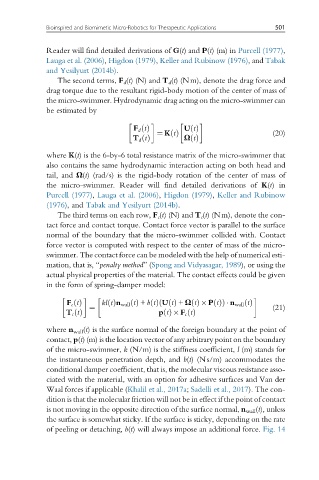Page 507 - Handbook of Biomechatronics
P. 507
Bioinspired and Biomimetic Micro-Robotics for Therapeutic Applications 501
Reader will find detailed derivations of G(t) and P(t) (m) in Purcell (1977),
Lauga et al. (2006), Higdon (1979), Keller and Rubinow (1976), and Tabak
and Yesilyurt (2014b).
The second terms, F d (t) (N) and T d (t) (Nm), denote the drag force and
drag torque due to the resultant rigid-body motion of the center of mass of
the micro-swimmer. Hydrodynamic drag acting on the micro-swimmer can
be estimated by
F d tðÞ U tðÞ
¼ K tðÞ (20)
T d tðÞ Ω tðÞ
where K(t) is the 6-by-6 total resistance matrix of the micro-swimmer that
also contains the same hydrodynamic interaction acting on both head and
tail, and Ω(t) (rad/s) is the rigid-body rotation of the center of mass of
the micro-swimmer. Reader will find detailed derivations of K(t)in
Purcell (1977), Lauga et al. (2006), Higdon (1979), Keller and Rubinow
(1976), and Tabak and Yesilyurt (2014b).
The third terms on each row, F c (t) (N) and T c (t) (Nm), denote the con-
tact force and contact torque. Contact force vector is parallel to the surface
normal of the boundary that the micro-swimmer collided with. Contact
force vector is computed with respect to the center of mass of the micro-
swimmer. The contact force can be modeled with the help of numerical esti-
mation, that is, “penalty method”(Spong and Vidyasagar, 1989), or using the
actual physical properties of the material. The contact effects could be given
in the form of spring-damper model:
F c tðÞ kl tðÞn wall tðÞ + btðÞ U tðÞ + Ω tðÞ P tðÞð Þ n wall tðÞ
¼ (21)
T c tðÞ p tðÞ F c tðÞ
where n wall (t) is the surface normal of the foreign boundary at the point of
contact, p(t) (m) is the location vector of any arbitrary point on the boundary
of the micro-swimmer, k (N/m) is the stiffness coefficient, l (m) stands for
the instantaneous penetration depth, and b(t) (Ns/m) accommodates the
conditional damper coefficient, that is, the molecular viscous resistance asso-
ciated with the material, with an option for adhesive surfaces and Van der
Waal forces if applicable (Khalil et al., 2017a; Sadelli et al., 2017). The con-
dition is that the molecular friction will not be in effect if the point of contact
is not moving in the opposite direction of the surface normal, n wall (t), unless
the surface is somewhat sticky. If the surface is sticky, depending on the rate
of peeling or detaching, b(t) will always impose an additional force. Fig. 14

